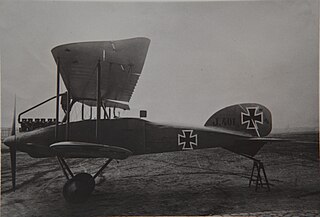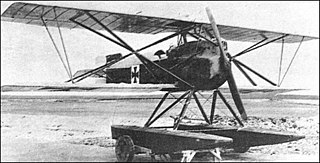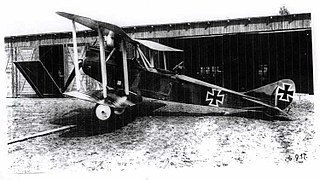The AEG DJ.I was a highly streamlined biplane ground attack aircraft of late World War I that was undergoing evaluation at the time of the Armistice.

The Albatros C.VII was a German military reconnaissance aircraft which saw service during World War I. It was a revised and re-engined development of the Albatros C.V, which had proved disappointing in service.

The Albatros J.I was a German armored ground attack airplane of World War I, produced in 1918.

The Hansa-Brandenburg KDW was a German single-engine, single-seat, fighter floatplane of World War I. The KDW – Kampf Doppeldecker, Wasser – was adapted from the Hansa-Brandenburg D.I landplane to provide coastal defence over the North Sea.
The Friedrichshafen FF.43 was a German single-seat floatplane fighter of the 1910s produced by Flugzeugbau Friedrichshafen.
The Friedrichshafen FF.48 was a German two-seat floatplane fighter of the 1910s produced by Flugzeugbau Friedrichshafen.

The Rumpler C.IV was a German single-engine, two-seat reconnaissance biplane. It was a development of C.III with different tail surfaces and using a Mercedes D.IVa engine in place of the C.III's Benz Bz.IV. The Rumpler 6B 2 was a single-seat floatplane fighter variant with a 120 kW (160 hp) Mercedes D.III engine built for the Kaiserliche Marine.

The Hansa-Brandenburg W.19 was a German fighter-reconnaissance aircraft of World War I. It was a single-engined two-seat biplane floatplane, and was a larger development of the successful W.12. It served with the Kaiserliche Marine during 1918.

The Hansa-Brandenburg CC was a single-seat German fighter flying boat of World War I. It was used by both the Kaiserliche Marine and the Austro-Hungarian Navy.

The Hansa Brandenburg W.27 and W.32 were prototype fighter floatplanes developed in parallel in Germany during World War I. They were developments of and intended replacements for the W.12 then in service and differed from each other principally in the choice of powerplant, the W.27 with a Benz Bz.IIIb and the W.32 with the same Mercedes D.III that the original W.12 used.

The Rumpler G.I was a bomber aircraft produced in Germany during World War I, together with refined versions known as the G.II and G.III.

The Zeppelin-Lindau CL.II was a German single-engine two-seat biplane with an all metal structure, built by Zeppelin-Lindau during World War I.
The Aviatik C.IX was a prototype German observation aircraft built by Aviatik in the final months of World War I.

The Kondor D 2 was a German single seat, biplane fighter aircraft designed and built close to the end of World War I.
The LVG C.VIII was a prototype reconnaissance aircraft built in Germany during World War I.
The Märkische D.I was a prototype single-seat fighter biplane built in the last months of World War I.
Hansa-Brandenburg W.34 was a prototype German two-seat, single-engined floatplane, which had been designed by Hansa und Brandenburgische Flugzeugwerke during World War I.

The Hansa-Brandenburg W.18 was a single-seat German fighter flying boat of World War I. It was used by both the Kaiserliche Marine and the Austro-Hungarian Navy.
The Hansa-Brandenburg W.25 was a German floatplane fighter of the World War I era, designed and built by Hansa-Brandenburg.
The Friedrichshafen FF.63 was a German experimental floatplane produced by Flugzeugbau Friedrichshafen.











